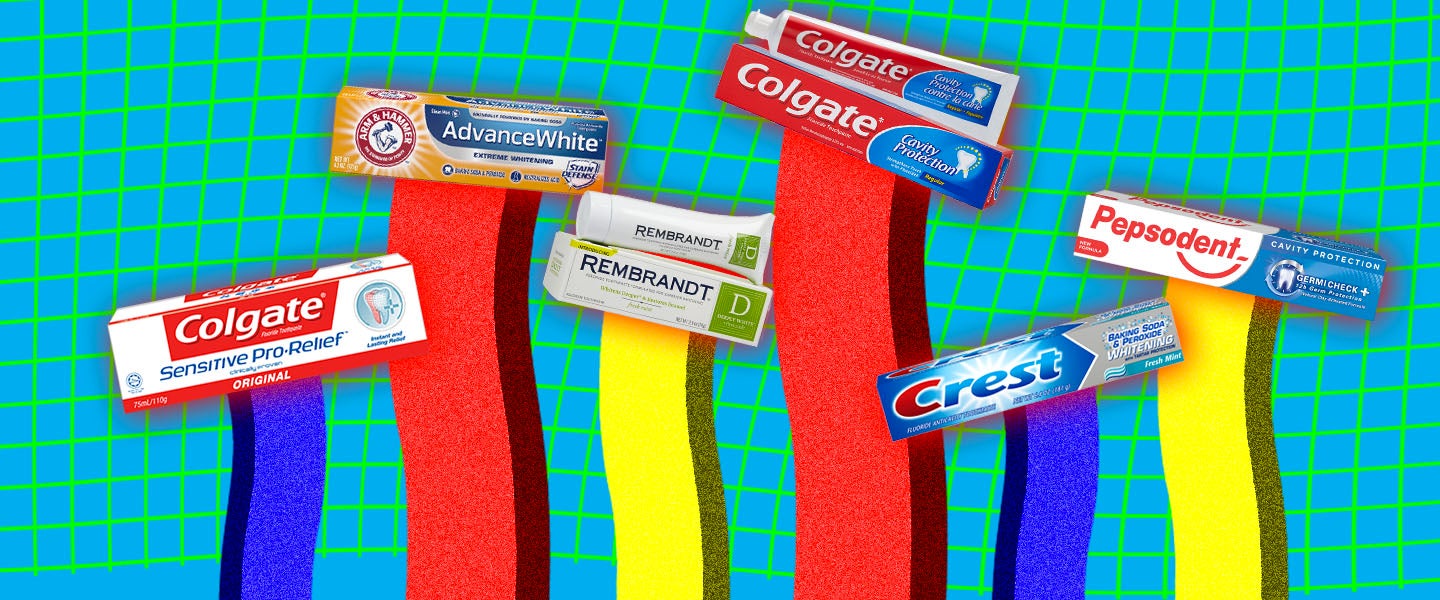Shopping for toothpaste can be a bewildering experience. There are tons of different brands, many of which come in various forms — whitening, sensitivity, tartar control. So how is anyone supposed to know which toothpaste is the best toothpaste?
In search of a simple answer, I asked Dr. Matthew Messina of the American Dental Association (ADA) to help me rank both brands and types of toothpaste by how effective they are. But — as you’ll notice from the fact that this week’s column looks completely different to how it normally does — apparently, that really isn’t possible.
The only thing that really matters is that whichever toothpaste you choose has the ADA Seal of Acceptance on the packaging. “Once a product has the ADA Seal of Acceptance, that’s the Dental Association’s mark that the product’s claims have been independently verified and tested by the association,” Messina explains. “That’s kinda the dentist’s mark that a product does what it says and says what it does. It’s safe and effective when used as directed, which is a fabulous piece of information.”
So at the end of the day, any brand with the seal will be safe to use — after that, a lot of it’s simply personal preference. “Some people like the taste of certain brands better than the taste of other brands, the same way that people like one Cola over another, or there’s this whole beer thing that’s going on these days,” says Messina.
You’ll also consider the specific function of that toothpaste — things like whitening, sensitivity and tartar control — but again, none of these things is inherently better than the other, they’re just designed to do different jobs. “There are different chemical components that have been formulated into the toothpaste to do different things,” Messina explains. “In other words, a toothpaste that’s anti-sensitivity has chemical agents in it that are designed to plug the little tubules and exposed root surfaces of the teeth to reduce sensitivity, which is great if you have sensitive teeth, but it doesn’t do anything for you if you don’t.”
Meanwhile, whitening toothpastes could theoretically have the opposite effect, meaning they might be a bad choice for someone with sensitive teeth. “Whitening toothpastes have a chemical agent in them — it’s a cousin, usually, of a peroxide of some sort — that has sort of a bubbling, cleansing action on the surface of the teeth that can remove some stains from the teeth, but you won’t ever see a whitening, anti-sensitivity toothpaste, because those have opposite actions,” Messina explains. “So you get one or the other.” It’s also worth making clear that whitening toothpastes don’t change the actual color of your teeth — they simply help remove some surface stains, potentially giving the teeth a lighter appearance, but they won’t make yellow teeth white.
Speaking of whitening toothpastes, some brands — namely Arm & Hammer — make a big deal of the fact that their products contain baking soda, which always seems like a weird thing to get excited about. It essentially does the same thing as whitening toothpaste: It acts as a mild abrasive to remove surface stains that might otherwise make your teeth look yellowish. While that’s all good and fine, much like whitening toothpastes, those that contain baking soda are also probably a bad choice for people with sensitive teeth, and combined with vigorous brushing, can potentially damage the outer coating of your teeth over time.
The other big toothpaste type is tartar control, which obviously slows the development of tartar, hard calcified deposits that can form on the teeth and cause them to decay. “Tatar control toothpastes have agents in them that stop or reduce the tartar from chemically attaching to the tooth,” Messina says. “So once again, that’s great if you build a lot of tartar, but not necessarily for you in particular.” Similar to whitening toothpastes, tatar control toothpastes won’t remove tatar that’s already there — they simply help keep more from forming.
You might also come across so-called “natural” or “herbal” toothpastes in some stores, but these are a little all over the place in terms of effectiveness. “One of the challenges with those is terms like ‘natural’ or ‘herbal’ are very poorly defined, so we defer to ‘look for the seal,’ because if it has the ADA seal of acceptance, then what the product says that it’s doing has been verified,” says Messina. “Other than that, I really don’t know. I can tell you what seal products do and have; I can’t tell you anything about a non-seal product, because it hasn’t been tested, at least by us, anyway.”
All in all, the best toothpaste for you could very well be the worst toothpaste for someone else, which means, as I said earlier, that there’s no real way to rank toothpastes by how effective they are. “This is where, in consultation with your dentist and the dental team, they can help you determine what’s best for you,” Messina emphasizes. “It’s entirely possible — let’s say we have a household with two parents and a couple of kids — we could have four different toothpastes, or three different toothpastes for different reasons. Somebody may have more issues with periodontal disease, so a tartar control toothpaste or an antibacterial toothpaste may be the right answer. The other adult may have sensitivity, and so they need an anti-sensitivity toothpaste. The teenage daughter going to prom may want a whitening toothpaste, and the other kids need just regular fluoride toothpaste.”
So, much like buttplugs, there really is no one-size-fits-all approach to toothpaste: You just have to find the one that gets the job done for you.

